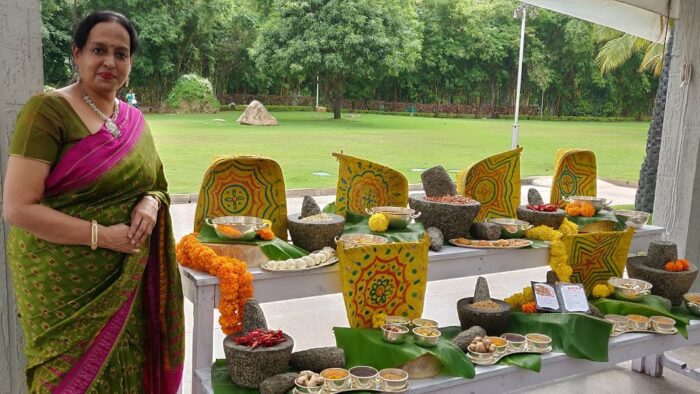Interview with Gita Hari, Writer, Culinary Expert & Food Curator on the vegetarian cuisine typical to Tamil Brahmin community in south India, which leans towards Satvik food
Indian vegetarian cuisine is unique in its diversity. The subcontinent is divided into many regions and each region’s climate, habits and traditions majorly influence the cuisine. Amongst the factors that influence the age-old culinary traditions are - health and wellness. In south of India, the Tamil Nadu Brahmin cuisine is largely Satvik - vegetarian that only uses ingredients that induce goodness and harmony in the body.

Gita Hari is a journalist and food critic. She is a zero-waste kitchen promoter, culinary expert and curator of Tam Brahm (Tamil Brahmin) satvik food for Premium hotels across India. A mother to her two sons, she loves to travel and aims to make Tam Brahm food popular across the globe.
Gita does not have formal training in hospitality or designing menus. But being a seasoned journalist and having written on food, and reviewed restaurants, she tasted food from across the country and the world. Eventually, she realised she was eating at odd hours and a lot of unhealthy food. And, this led to her going back to her roots. “It dawned upon me that home-cooked food, native to me, was the best. I became passionate about spreading the word to make people aware of Ayurvedic food or satvik cuisine. The transition to curating this cuisine came easily to me as it was in my roots and I only had to tap into it,” she shares.
The knowledge of food was indeed handed down by her mother and mother-in-law, and some she researched on her own. And she believes in curating menus and food festivals that follow the basic tenets – Eat Healthy, Be Healthy.
Gita has also hosted food shows on the digital platform and for a TV Channel called Spin TV.
One of her Tam Brahm Sattvik food promotions was held at the renowned wellness retreat Viveda Wellness Village in Nashik, which specialises in Ayurvedic treatments and satvik food.
She gives a peek into Satvik Tam Brahm cuisine during an interview with Indica VEGA.
Excerpts from the interview:

What is your definition of Satvik food?
There are three kinds of gunas in humans – Sattva, Rajas and Tamas and they affect us intensely. Sattva represents purity, knowledge and harmony, Rajas denotes passion, energy and action while Tamas manifests as inertia, unethical, egoistic. There are foods which correspond to these gunas. Satvik food takes care of your body, mind and soul. Pleasing to the palate, tummy-friendly, and with a calming effect on the mind, satvik food is the answer to holistic well-being. Certain ingredients like onion and garlic generate heat in the body giving rise to anger, aggravation, even lust and greed. They are best avoided or if essential, to be taken in smaller portions and not very often. Eat in moderation and always stop when you feel like having that one last helping.
What are the key ingredients that are a must in your Satvik kitchen?
Immunity-boosting ingredients like fresh vegetables, lentils, lemon, ginger, turmeric, herbs like coriander and curry leaves are of primary importance. I use hing or asafoetida which aids digestion, fenugreek seeds for lowering cholesterol and the probiotic curd/buttermilk liberally. Ghee or clarified butter is a gut-healthy cooking fat I use to season curries and gravies. It heals the stomach lining damaged by gastric acid. I avoid white salt, white sugar and white or refined flour. Instead I use jaggery, Himalayan or rock salt, and whole wheat or multigrain atta.
Can you explain to us a typical meal in a Tam Brahm house, and your views on the ingredients and method of cooking?
 Predominantly rice consumers, Tam Brahm staples are steamed rice, tuvar dal with ghee, sambar, rasam, poriyal or thoran (cut veggies, boiled and lightly sautéed, tempered with grated coconut and green chillies in coconut oil) ending with curd rice. For that zesty kick a bit of puli injhi (green chillies and fresh ginger pieces in tamarind sauce), lemon or mango pickles, all in moderation. Papadams or appalams, vadam/karvadam (sun dried rice/sago fritters) are a must on special occasions.
Predominantly rice consumers, Tam Brahm staples are steamed rice, tuvar dal with ghee, sambar, rasam, poriyal or thoran (cut veggies, boiled and lightly sautéed, tempered with grated coconut and green chillies in coconut oil) ending with curd rice. For that zesty kick a bit of puli injhi (green chillies and fresh ginger pieces in tamarind sauce), lemon or mango pickles, all in moderation. Papadams or appalams, vadam/karvadam (sun dried rice/sago fritters) are a must on special occasions.
The ingredients used in daily cooking like lentils, fresh vegetables, curd, coconut are anti-inflammatory, gut-healthy, probiotic and eaten in moderation, can go a long way in keeping us in excellent health in our autumn years as well. Only Indian vegetables are consumed while cauliflower, mushrooms, and the like are not normally used.
From the morning cuppa of filter coffee, to the finale of curd rice and payasam, we have our unique cooking methods. Coffee filter and in some homes coffee grinder too, are mandatory for that eye-opener beverage. The cooking technique of meals is uncomplicated and involves boiling, mild sautéing, which help retain the nutritional values of the ingredients used.
How do eaters from across India respond to your food? What are your must have specialities on your menu?
I am proud of the cuisine of Palakkad, the native land to which I belong. The food here is harmless, improves health and is light on the stomach. I keep my Palakkad TamBrahm meals authentic and don’t attempt to fuse it with others just to please the palate of the guests of premier hotels where I conduct my food events. I do bring in a bit of Tanjavur/Tamil Nadu dishes like Vethakoyambu, Puliyodarai for variety. Mostly vegetarians like Kannadigas, Gujaratis and Marwaris-Jains have shown very positive and encouraging response while North Indians like Sindhis and Punjabis have their reservations due to lack of onion and garlic. They do relish a few items, for instance, my Mango Puliseri which resembles kadhi is very popular with all communities. Venn Pongal, varieties of Rasam have got tremendous response from guests across India. Recently, after the pandemic, diners have become conscious of their health and prefer vegetarian food even while dining out and satvik food caters to this newfound attitude towards wellbeing.
I make it a point to include mango puliseri, rasam, thorans, varieties of rice like lemon/curd/coconut/tamarind rice and papadams along with Kerala banana chips. Avial is a favourite among guests and so is mung dal koshambari. Payasam is a specialty where fine rice is cooked in jaggery, garnished with chopped nuts and raisins in pure ghee.





